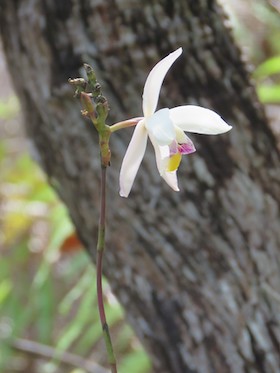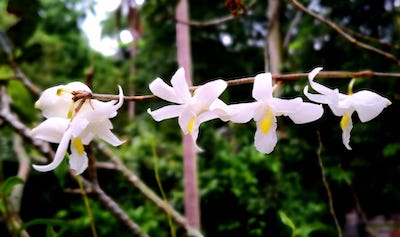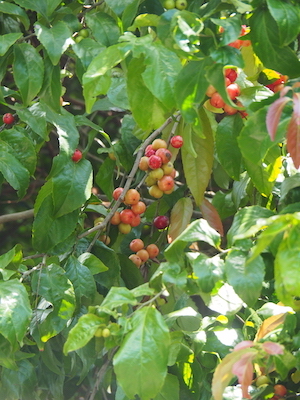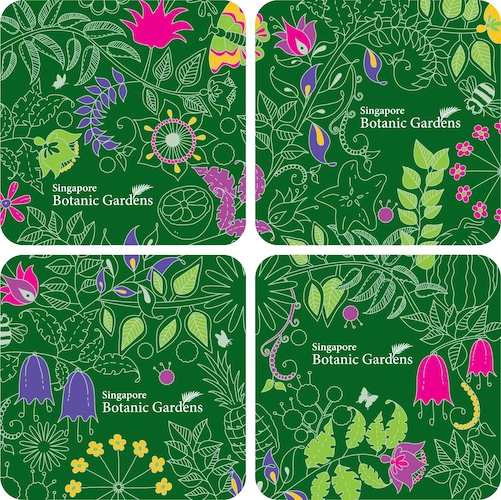Our Native Orchids
Did you know that some 224 species of orchids have been recorded as native in Singapore? This means that they are found growing naturally in our forests and nature reserves!
While the majority of these native beauties are considered Nationally Extinct and Critically Endangered, five species are considered to be of Least Concern and can actually be seen growing along our streets and in our many green spaces.
Get to know more about these five orchids here:
Bamboo Orchid
Photo credit: Boo Chih Min
The Bamboo Orchid (Arundina graminifolia) gets its name from its stem that can grow to more than 1.5 m in height, as well as its slender bamboo-like leaves. Found in open grasslands, its flower is a a striking mix of white and lavender or a deep violet-pink combination, with a hint of yellow in the throat.
It is occasionally cultivated as an ornamental plant for its attractive flowers. It is free-flowering throughout the year once established in optimal conditions.
Spathoglottis Orchid
Photo credit: Jennie Tang Yurue
The Spathoglottis Orchid (Spathoglottis plicata Blume) is a free-flowering species that is commonly found in Singapore. Its pinkish purple flowers occur in groups of five to 30, and open a few at a time.
It is also commonly cultivated as an ornamental plant. It requires bright light to flower and grows well in soil that is porous and does not retain water. It also benefits from sprays of organic fertiliser such as fish emulsion.
Grass Orchid
The Grass Orchid (Eulophia graminea) has small, greenish yellow flowers with brown, net-like markings. Its white crested lip has a dark purplish red centre. Each inflorescence stalk bears about 10 to 20 flowers.
Also known as Bawang Hantu, this native orchid often sprouts from new soil in development sites. This terrestrial species can be grown in a sunny location with direct sunlight. At home, you can grow it in a pot with well-drained and moisture-retentive soil.
Finlayson's Bromheadia
Photo credit: Reuben Lim
The Finlayson's Bromheadia (Bromheadia finlaysoniana) has slightly fragrant flowers with white or creamy petals, as well as a purple-veined lower lip with a yellow centre. Blooming tends to occur a few days after rain. The flowers open in the morning and last only for a few hours, typically fading by afternoon.
This common native species can be seen in areas such as Bukit Timah Nature Reserve, Kent Ridge Park, the Western Catchment area, Pulau Ubin and Pulau Tekong.
Pigeon Orchid
Photo credit: Tee Swee Ping
The Pigeon Orchid (Dendrobium crumenatum) is an epiphytic species that is commonly seen on roadside trees around Singapore. Its flowers bear a strong resemblance to flying pigeons, hence its name.
It blooms approximately nine days after heavy rainstorms, as the drop in temperature that typically happens after such rains triggers the flowering of this orchid. The flowers then attract bees, which cross-pollinate the orchids.
National Orchid Garden
Be enthralled by an abundance of flowers, foliage and scents at the National Orchid Garden. The Tropical Montane Orchidetum showcases the most diversity of orchids found in tropical montane forests, in a single location in Singapore.
It comprises three display houses – the Sembcorp Cool House, Tan Hoon Siang Mist House, Yuen Peng McNeice Bromeliad Collection, as well as the surrounding outdoor display areas that showcase lowland forest and stream habitats, and a Secret Ravine that emulates habitats that can be found in deep, narrow valleys of tropical mountains.
Safe Management Measures have been put in place for the safety of all visitors. Please expect waiting times of 1 to 2 hr to enter the National Orchid Garden during peak hours.
Growing Orchids At Home
Can’t get enough of the beauty of the orchids? You do not need to have a big garden or yard to grow them. Advancements in orchid hybridisation over the past few decades have created hybrids that can grow well even in an apartment with a balcony or any sunny space for plants.
Learn more about growing orchids in apartments here.
Gardeners’ Day Out Is Back!
Participate from the comfort of your home with online activities such as talks and demonstrations, video tutorials of activities and promotions offered. Free guided tours will also be offered on site (with safe management measures). Enjoy Gardeners’ Day Out online at www.nparks.gov.sg/GDO.
You can also enjoy our Gardening With Edibles Masterclass Series from your home. They are conducted by NParks horticulturists, focusing on unique and challenging edibles across different plant families.
Learning More
If you are heading to our green spaces, do the right thing and be socially responsible. Maintain a safe distance from other park goers and keep to not more than five persons in a group, with no intermixing between groups. Always wear a mask except when you are engaged in strenuous exercise or when consuming food, drink or medication.
Do check out the visitorship levels of our parks using our safe distancing portal before you head down and avoid the ones with high visitorship. Learn about some simple do’s and don’ts when visiting our Nature Reserve and Nature Parks here.
Visit NParksSG, our refreshed YouTube Channel that serves as a one-stop repository for close to 300 video resources. It also provides you a platform for existing and future digital outreach including DIY gardening and related crafts, virtual tours of our green spaces, and livestream events.
Whether you are an amateur gardener or a seasoned horticulturist, starting a home garden or a community garden, there are plenty of useful information and guides here for your gardening hobby.
For more information about the flora and fauna found in Singapore, please visit NParks Flora and Fauna Web.
If you like what you read, follow us on Facebook, Instagram and Telegram to get the latest updates.
Text by Charlotte Tan


.ashx)
.ashx)
.ashx)




Have views or comments on this article? Let us know via this form. If you would like to give us feedback on any other areas relating to our parks and gardens, please submit via https://www.nparks.gov.sg/feedback